外研社版三起英语四年级下册第十单元教案
外研社(三起)四年级英语第三册:Module 10 The Months Unit 1 There
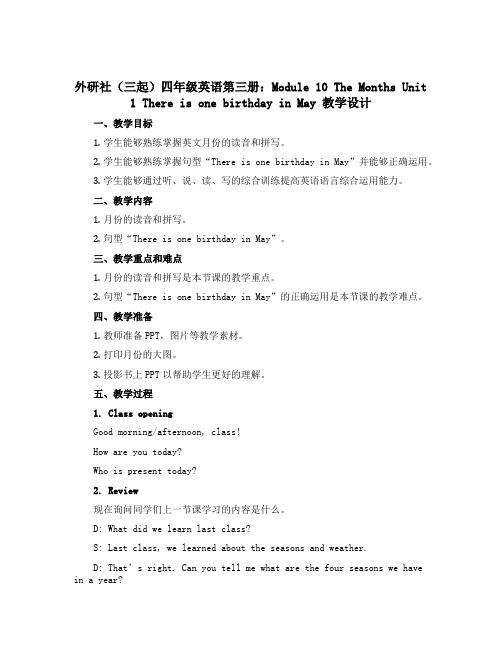
外研社(三起)四年级英语第三册:Module 10 The Months Unit1 There is one birthday in May 教学设计一、教学目标1.学生能够熟练掌握英文月份的读音和拼写。
2.学生能够熟练掌握句型“There is one birthday in May”并能够正确运用。
3.学生能够通过听、说、读、写的综合训练提高英语语言综合运用能力。
二、教学内容1.月份的读音和拼写。
2.句型“There is one birthday in May”。
三、教学重点和难点1.月份的读音和拼写是本节课的教学重点。
2.句型“There is one birthday in May”的正确运用是本节课的教学难点。
四、教学准备1.教师准备PPT,图片等教学素材。
2.打印月份的大图。
3.投影书上PPT以帮助学生更好的理解。
五、教学过程1. Class openingGood morning/afternoon, class!How are you today?Who is present today?2. Review现在询问同学们上一节课学习的内容是什么。
D: What did we learn last class?S: Last class, we learned about the seasons and weather.D: That’s right. Can you tell me what are the four seasons we havein a year?等学生回答完毕后,老师过渡到本节课的教学。
3. Presentation•Introduce the 12 months of the year using a PPT, showing the pictures of each month.•Model the sentence。
四年级英语下册Module10Unit2Samhadlotsofchocolates教案设计外研版(三起)
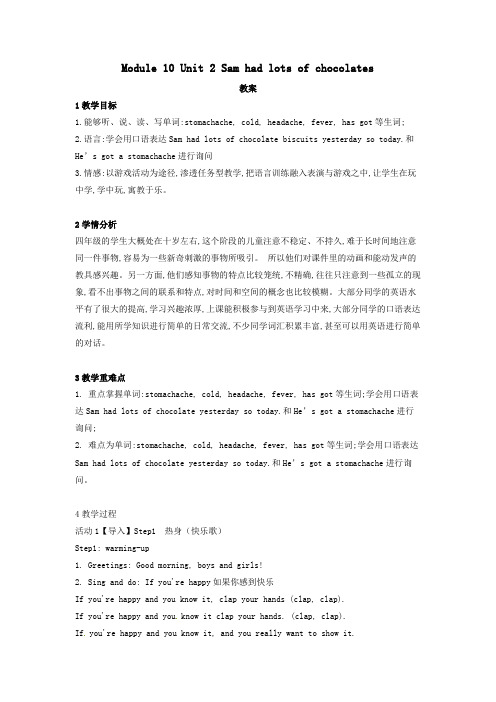
Module 10 Unit 2 Sam had lots of chocolates教案1教学目标1.能够听、说、读、写单词:stomachache, cold, headache, fever, has got等生词;2.语言:学会用口语表达Sam had lots of chocolate biscuits yesterday so today.和He’s got a stomachache进行询问3.情感:以游戏活动为途径,渗透任务型教学,把语言训练融入表演与游戏之中,让学生在玩中学,学中玩,寓教于乐。
2学情分析四年级的学生大概处在十岁左右,这个阶段的儿童注意不稳定、不持久,难于长时间地注意同一件事物,容易为一些新奇刺激的事物所吸引。
所以他们对课件里的动画和能动发声的教具感兴趣。
另一方面,他们感知事物的特点比较笼统,不精确,往往只注意到一些孤立的现象,看不出事物之间的联系和特点,对时间和空间的概念也比较模糊。
大部分同学的英语水平有了很大的提高,学习兴趣浓厚,上课能积极参与到英语学习中来,大部分同学的口语表达流利,能用所学知识进行简单的日常交流,不少同学词汇积累丰富,甚至可以用英语进行简单的对话。
3教学重难点1. 重点掌握单词:stomachache, cold, headache, fever, has got等生词;学会用口语表达Sam had lots of chocolate yesterday so today.和He’s got a stomachache进行询问;2. 难点为单词:stomachache, cold, headache, fever, has got等生词;学会用口语表达Sam had lots of chocolate yesterday so today.和He’s got a stomachache进行询问。
4教学过程活动1【导入】Step1 热身(快乐歌)Step1: warming-up1. Greetings: Good morning, boys and girls!2. Sing and do: If you're happy如果你感到快乐If you're happy and you know it, clap your hands (clap, clap).If you're happy and you know it clap your hands. (clap, clap).If you're happy and you know it, and you really want to show it.If you're happy and you know it, clap your hands. (clap, clap).If you're happy and you know it, stomp your feet (stomp, stomp).If you're happy and you know it stomp your feet (stomp, stomp).If you're happy and you know it, and you really want to show it.If you're happy and you know it, stomp your feet (stomp, stomp).If you're happy and you know it, shout hurray (hurray, hurray).If you're happy and you know it shout hurray (hurray, hurray).If you're happy and you know it, and you really want to show it.If you're happy and you know it, shout hurray (hurray, hurray).If you're happy and you know it, do all three (clap, stomp, hurray!).If you're happy and you know it do all three (clap, stomp, hurray!).If you're happy and you know it, and you really want to show it.If you're happy and you know it, do all three (clap, stomp, hurray!)设计意图:活跃了课堂气氛,拉近了师生间的距离。
( 英语 )四年级新标准英语外研版下册教案Module 10 Accidents

Module 10 AccidentsUnit 1 Sam fell off his bike.一、教学目标:知识与技能:Words and phrases: happen、ride、then、thirsty、watermelon、carry、bump2. Sentences: Sam and I went for a bike ride yesterday.And then ……?3. Past form of the verbs:happen --- happened bump---bumped carry--- carriedgo---went are---were buy------bought fall-----fell过程与方法:有趣的引导情感、态度和价值观:通过有趣的课文内容让学生更加强过去式德育目标:指出因果关系二、重点:Words and phrases: happen ride then thirsty watermelon carry bump三、难点:Sentences: Sam and I went for a bike ride yesterday.And then ……?3. Past form of the verbs:happen --- happened bump---bumped carry--- carriedgo---went are---were buy------bought fall-----fell四、教具:单词卡片、录音机五、教学过程:(一)导入:Free talk: I did ……yesterday.(二)探究新知New concepts:Warming upOn the cards, write the present and past tense forms of some irregular verbs.Examples: go---went are---were buy---bought fall-----fellT: Today, We’ll learn the new verbs and their past tense forms.Then teach: happen----happened bump-----bumped carry-----carriedAsk and answerT: We did many things yesterday. Who can tell me who you did yesterday?T: What did you do yesterday, A?Sa: I played basketball yesterday.T: What did Sa do yesterday?Sb: He/She played basketball yesterday.Then ask several the other students like this.Tell the story :T: Now, look at your books. Module 10 Accidents Unit 1 Sam fell of his bike.Listen to the tape and underline the new words. (Show the cards of new words)Teach the new words.T: Now listen to the tape again and repeat it .Are you clear?T: Now listen to the tape again and answer: What did Sam and Daming do yesterday? Ask students to look at the CAIS1: They went for a bike ride yesterday.T: And then ……? (Ask students to look at the CAI and a nswer)(三)巩固新知ReadAsk students to use all kinds of ways to read the text well.Tell the storyAsk students to look at the CAI and tell the story. For example:T: Sam and Daming went for a bile ride yesterday .T: And then……?S1: They were hungry and thirsty .S2 :And then ……?S3: They bought a watermelon.……(四)作业布置Homework 复习巩固过去时六、板书设计Module 10 AccidentUnit 1 Sam fell of his bike.Cards: happen ride then thirsty watermelon carry bump(1) happen---happened bump---bumped(2) carry---carried(3) go ---went are---were buy---bought fall---fell七、教学反思Unit 2 Sam had lots of chocolate biscuits. 一、教学目标:知识与技能:Words and phrases: stomachache, cold, headache, fever,fall off, fell off.2.Sentences: Sam had lots of chocolate biscuits yesterday.So today he’s got a stomachache.3.Grammar: Talking about illnesses.过程与方法:讲授、过去时情感、态度和价值观:有时干家务也挺好的德育目标:劳动光荣二、重点:Words and phrases: stomachache, cold, headache, fever, fall off, fell off.三、难点:Sentences: Sam had lots of chocolate biscuits yesterday.So today he’s got a stomachache.3. Grammar: Talking about illnesses.四、教具:单词卡片、录音机五、教学过程:(一)导入:Step 1 Warm-upT: Hi, boys and girls.T: Let’s sing a song, ok?Ss: Ok.T: Ok! London Bridge is falling down…. (Ss sing the song)T: You are cle ver boys and girls. Now let’s have a Free Talk “What I did yesterday”, Ok?Ss introduce what they did yesterday(二)探究新知Step 2 Presentation and leadingT: Who can tell me what happen to Daming in last Unit.Ss: Daming’s head was bumped.T: Let’s play this s tory, ok?Ss: Ok.(Two students play in roles of “Daming” and “Sam”, others describe the story, the two students do the actions)The teacher writes the word “today” on the blackboard. What happened to Daming, Sam, Amy and Lingling? Lead the students to use “to” and “and” to connect the two sentences.Step 3 Text TeachingT: Now, this class we are going to learn Module 10 Unit 2 Sam had lots of chocolate biscuits .First, listen to the tape and underline the new words.(Teach the new words’ cards)T: Now listen to the tape and repeat it. Are you clear?(The teacher writes these sentences on the blackboard)Sam had lots of chocolate biscuits yesterday.So today he’s got a stomachache.T: Now listen to the tape again and tell me what happened to Sam, Lingling, Amy and Lingling.T: Look at these words: had, ate(三)巩固新知Step 4 Task-FulfillingT: Let’s play a game, ok? Ss: Ok.T: Let’s play “I do you say”. I’ll ask four students to come to the front of the class, one student performs Daming eating chocolate biscuits and then having a stomachache, and others describe it, and so on.Step 5 Text LearningT: Look at Part 4, answer these questions:What is wrong with Little Tommy?What’s wrong with Little Lingling?What’s wrong with Little Ben?T: Listen to the tape and repeat it.T: Let’s read the poem together and do the actions, ok?Ss: Ok.(四)作业布置Homework运用过去时造句六、板书设计Unit 2 Sam had lots of chocolate biscuitsSam had lots of chocolate biscuits yesterday.So today he’s got a stomachache.七、教学反思。
四年级下册英语-名师教学设计-第十模块-第一单元-外研版三起
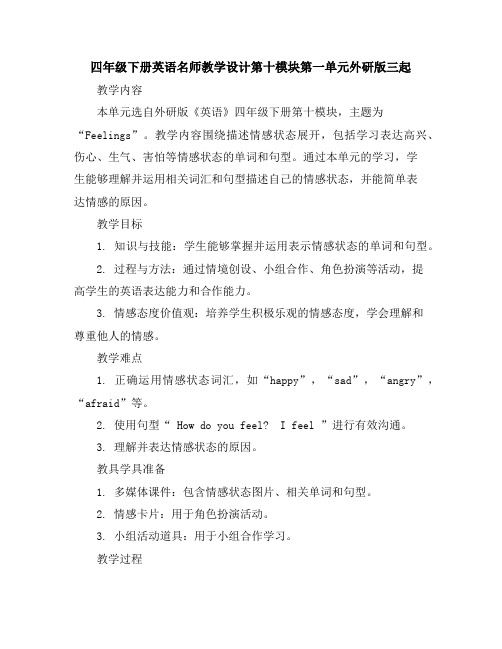
四年级下册英语名师教学设计第十模块第一单元外研版三起教学内容本单元选自外研版《英语》四年级下册第十模块,主题为“Feelings”。
教学内容围绕描述情感状态展开,包括学习表达高兴、伤心、生气、害怕等情感状态的单词和句型。
通过本单元的学习,学生能够理解并运用相关词汇和句型描述自己的情感状态,并能简单表达情感的原因。
教学目标1. 知识与技能:学生能够掌握并运用表示情感状态的单词和句型。
2. 过程与方法:通过情境创设、小组合作、角色扮演等活动,提高学生的英语表达能力和合作能力。
3. 情感态度价值观:培养学生积极乐观的情感态度,学会理解和尊重他人的情感。
教学难点1. 正确运用情感状态词汇,如“happy”,“sad”,“angry”,“afraid”等。
2. 使用句型“ How do you feel? I feel ”进行有效沟通。
3. 理解并表达情感状态的原因。
教具学具准备1. 多媒体课件:包含情感状态图片、相关单词和句型。
2. 情感卡片:用于角色扮演活动。
3. 小组活动道具:用于小组合作学习。
教学过程1. 课堂导入:通过展示不同情感状态的图片,引导学生猜测并说出相应的情感词汇。
2. 新知呈现:利用多媒体课件展示单词和句型,教师进行讲解和示范。
3. 小组合作:学生分组,每组选择一个情感卡片,讨论并准备如何用英语描述该情感状态。
4. 角色扮演:每组选择一名代表进行角色扮演,使用新学的句型表达情感状态。
5. 巩固练习:进行课堂练习,包括填空、选择、匹配等,巩固新学知识。
板书设计1. 情感状态词汇表:列出本节课学习的情感状态单词。
2. 句型结构展示:展示句型“ How do you feel? I feel ”的结构。
3. 情感状态原因表达:示例如何表达情感状态的原因。
作业设计1. 抄写并默写新学的情感状态词汇。
2. 完成练习册相关练习题。
3. 家长协助,用英语询问并描述家庭成员的情感状态。
课后反思本节课通过情境创设和小组合作,有效地帮助学生掌握了情感状态的表达。
四年级下册英语教案-Module10(2课时)|外研社(三起)
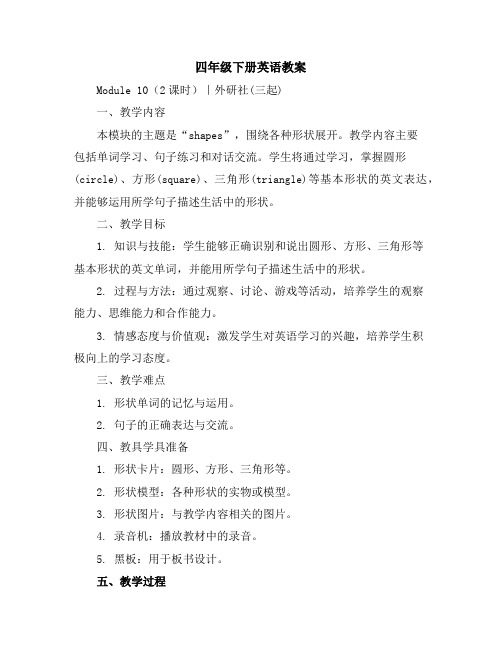
四年级下册英语教案Module 10(2课时)|外研社(三起)一、教学内容本模块的主题是“shapes”,围绕各种形状展开。
教学内容主要包括单词学习、句子练习和对话交流。
学生将通过学习,掌握圆形(circle)、方形(square)、三角形(triangle)等基本形状的英文表达,并能够运用所学句子描述生活中的形状。
二、教学目标1. 知识与技能:学生能够正确识别和说出圆形、方形、三角形等基本形状的英文单词,并能用所学句子描述生活中的形状。
2. 过程与方法:通过观察、讨论、游戏等活动,培养学生的观察能力、思维能力和合作能力。
3. 情感态度与价值观:激发学生对英语学习的兴趣,培养学生积极向上的学习态度。
三、教学难点1. 形状单词的记忆与运用。
2. 句子的正确表达与交流。
四、教具学具准备1. 形状卡片:圆形、方形、三角形等。
2. 形状模型:各种形状的实物或模型。
3. 形状图片:与教学内容相关的图片。
4. 录音机:播放教材中的录音。
5. 黑板:用于板书设计。
五、教学过程1. 导入:通过展示形状卡片,引导学生说出各种形状的英文单词,激发学生的学习兴趣。
2. 新课呈现:通过播放教材中的录音,引导学生学习新的单词和句子。
3. 操练:通过游戏、角色扮演等活动,巩固所学知识。
4. 应用:引导学生运用所学句子描述生活中的形状。
六、板书设计1. Module 10 Shapes2. 单词列表:circle, square, triangle等。
3. 句子:This is a(n) ______. It's ______.4. 对话示例:A: What shape is this? B: It's a circle.七、作业设计1. 抄写本节课所学的单词和句子。
2. 用所学句子描述家人或朋友喜欢的形状。
3. 收集生活中的形状图片,并用所学句子进行描述。
八、课后反思1. 教学过程中,是否充分调动了学生的学习积极性?2. 学生对形状单词和句子的掌握程度如何?3. 教学难点是否得到有效突破?4. 教学方法是否适合学生的认知特点?5. 课后作业是否有助于巩固所学知识?通过本模块的教学,使学生能够熟练掌握各种形状的英文表达,并能用所学句子描述生活中的形状,为今后的英语学习打下坚实基础。
四年级外研版英语下册module10-全单元教案
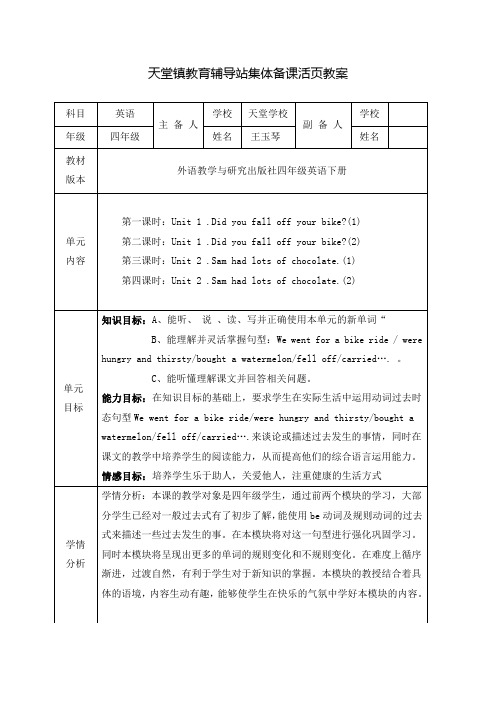
能力目标:能够在实践练习中熟练地运用本模块的新单词和句型并能够熟练的运用Did…?句型以及相应的回答。
情感目标:培养学生乐于助人,关爱他人,注重健康的生活方式。
教学重难点
教学重点:1.掌握词汇:fall, fall off, fell, fell down, found, town, happen, Ride, then, thirsty, water, bought, watermelon, carried, bump, hospital.
情感目标:培养学生乐于助人,关爱他人,注重健康的生活方式
学情分析
学情分析:本课的教学对象是四年级学生,通过前两个模块的学习,大部分学生已经对一般过去式有了初步了解,能使用be动词及规则动词的过去式来描述一些过去发生的事。在本模块将对这一句型进行强化巩固学习。同时本模块将呈现出更多的单词的规则变化和不规则变化。在难度上循序渐进,过渡自然,有利于学生对于新知识的掌握。本模块的教授结合着具体的语境,内容生动有趣,能够使学生在快乐的气氛中学好本模块的内容。
依次通过图片展示,引入went for a bike ride,thirsty, bought a watermelon,carried the watermelon,fell off the bike,bump,hospital等单词,强调单词过去式的形式。
(2).Practice the words.
2.巩固熟练的运用Did…?句型以及相
2.能够熟练运用重点句型的问答。
教学课时
四课时
教学课时
第一课时
板书设计
fall off your bike?
Did you buy some...?
小学英语外研版(三起)四年级下册Module+10+Unit+2+Sam+had+lots+of+chocolate+教案
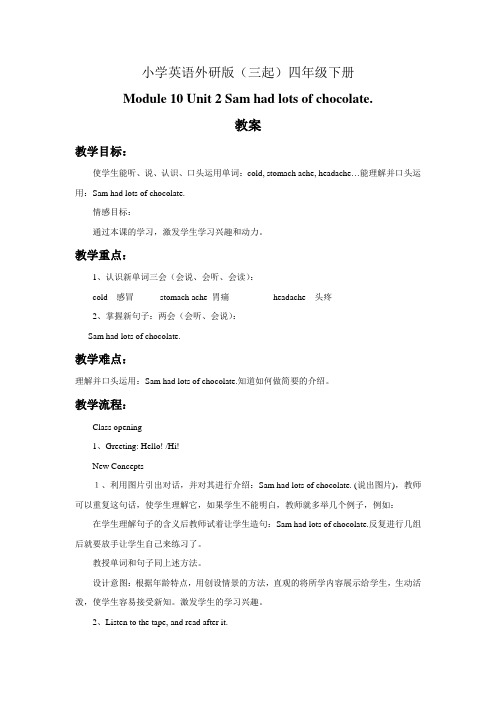
小学英语外研版(三起)四年级下册Module 10 Unit 2 Sam had lots of chocolate.教案教学目标:使学生能听、说、认识、口头运用单词:cold, stomach ache, headache…能理解并口头运用:Sam had lots of chocolate.情感目标:通过本课的学习,激发学生学习兴趣和动力。
教学重点:1、认识新单词三会(会说、会听、会读):cold 感冒stomach ache 胃痛headache 头疼2、掌握新句子:两会(会听、会说):Sam had lots of chocolate.教学难点:理解并口头运用:Sam had lots of chocolate.知道如何做简要的介绍。
教学流程:Class opening1、Greeting: Hello! /Hi!New Concepts1、利用图片引出对话,并对其进行介绍:Sam had lots of chocolate. (说出图片),教师可以重复这句话,使学生理解它,如果学生不能明白,教师就多举几个例子,例如:在学生理解句子的含义后教师试着让学生造句:Sam had lots of chocolate.反复进行几组后就要放手让学生自己来练习了。
教授单词和句子同上述方法。
设计意图:根据年龄特点,用创设情景的方法,直观的将所学内容展示给学生,生动活泼,使学生容易接受新知。
激发学生的学习兴趣。
2、Listen to the tape, and read after it.设计意图:让学生在模仿练习进一步熟练课文内容,并同时进行听力训练。
3、Play a game.游戏规则:让几名自告奋勇的学生面对全班站在教室的前面,教师站在这一排学生得一端拿着卡片提问。
设计意图:通过游戏使学生能有亲身体验,并激发他们的学习兴趣,在游戏中轻松愉悦地获得新知。
4、Make a dialogue in groups.设计意图:使学生在活动中发散思维,并培养他们的合作创新精神,能够运用所学知识进行简单的口语交流,培养自主学习能力。
Module10大单元整体备课(教学设计)-2023-2024学年外研版(三起)英语四年级下册

7.巩固学习效果,为后续学习打下基础。通过课后作业和拓展学习,学生将能够巩固本节课所学内容,为后续学习打下基础。
8.拓宽知识视野和思维方式。通过拓展学习和反思总结,学生将能够拓宽知识视野和思维方式,提高学习效果。
1.学习描述食物的基本词汇,如“apple”(苹果),“banana”(香蕉),“orange”(橙子)等。
2.学习描述食物的颜色和味道的形容词,如“red”(红色),“yellow”(黄色),“sweet”(甜)等。
3.学习询问和回答关于食物的问题,如“What's this?”(这是什么?),“It's a/an...”(它是一个/一个...),“What color is it?”(它是什么颜色的?),“It's...”(它是...)等。
设计预习问题:围绕食物的颜色和味道的形容词,设计一系列具有启发性和探究性的问题,引导学生自主思考。例如,问题可以是:“请用英语描述一下你最喜欢的食物的颜色和味道。”
监控预习进度:利用平台功能或学生反馈,监控学生的预习进度,确保预习效果。例如,可以通过在线平台的讨论区,让学生提交自己的预习笔记或思维导图,教师可以查看学生的预习进度并进行指导。
教师活动:
布置作业:根据食物的颜色和味道的形容词,布置适量的课后作业,巩固学习效果。例如,可以布置一道题目,要求学生用英语描述自己最喜欢的食物的颜色和味道。
提供拓展资源:提供与食物的颜色和味道的形容词相关的拓展资源(如书籍、网站、视频等),供学生进一步学习。例如,可以推荐一些相关的英语学习网站或视频,供学生进行自主学习。
2.能够运用英语描述食物的颜色和味道。通过课堂活动的参与和实践,学生将能够运用所学词汇和形容词,如“It's a red apple.”(这是一个红色的苹果。),“I like sweet bananas.”(我喜欢甜的香蕉。)等,来描述食物的特性。
【优质】小学英语外研版四年级下册第10模块优质公开课教案
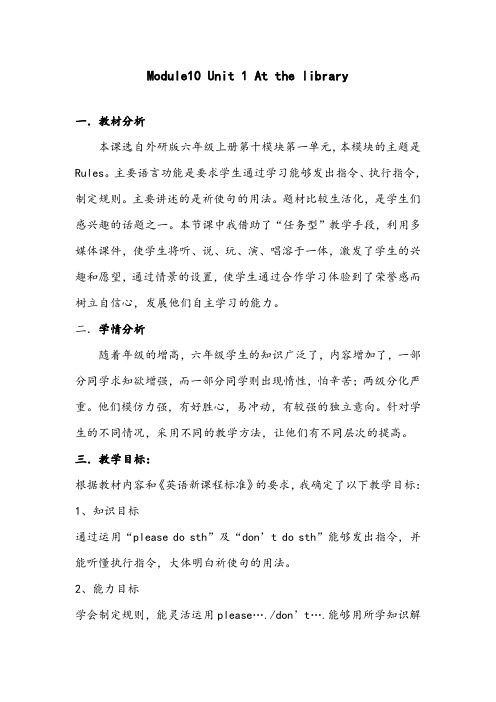
Module10 Unit 1 At the library一.教材分析本课选自外研版六年级上册第十模块第一单元,本模块的主题是Rules。
主要语言功能是要求学生通过学习能够发出指令、执行指令,制定规则。
主要讲述的是祈使句的用法。
题材比较生活化,是学生们感兴趣的话题之一。
本节课中我借助了“任务型”教学手段,利用多媒体课件,使学生将听、说、玩、演、唱溶于一体,激发了学生的兴趣和愿望,通过情景的设置,使学生通过合作学习体验到了荣誉感而树立自信心,发展他们自主学习的能力。
二.学情分析随着年级的增高,六年级学生的知识广泛了,内容增加了,一部分同学求知欲增强,而一部分同学则出现惰性,怕辛苦;两级分化严重。
他们模仿力强,有好胜心,易冲动,有较强的独立意向。
针对学生的不同情况,采用不同的教学方法,让他们有不同层次的提高。
三.教学目标:根据教材内容和《英语新课程标准》的要求,我确定了以下教学目标:1、知识目标通过运用“please do sth”及“don’t do sth”能够发出指令,并能听懂执行指令,大体明白祈使句的用法。
2、能力目标学会制定规则,能灵活运用please…./don’t….能够用所学知识解释生活中各种事物。
例如马路上的标牌等。
3、情感目标通过各种形式的活动,以及虚拟的学校、图书馆等情景表演中,激发学生学习的兴趣,挖掘他们表演的潜力,以及与他人合作,共同完成学习任务,培养学生的组织能力和合作精神。
四.教学重、难点1、掌握并灵活运用please…/don’t…初步了解祈使句的用法。
2、能够制定规则。
五.课前准备:单词卡片、多媒体课件。
六.教学方法:根据英语这门课本身的特点及六年级学生的兴趣,知识的输入量我采用了以旧带新,不断滚动知识点的方法进行教学,以此来分散重难点,让学生直观的感知与理解。
同时创设数个任务活动,使学生在师生、生生之间的多向交流中进行有意义的练习与实践,充分发挥他们的学习主体性,培养他们学以致用的能力。
四年级下英语教案-Robotswilldoeverything-外研社(三起)
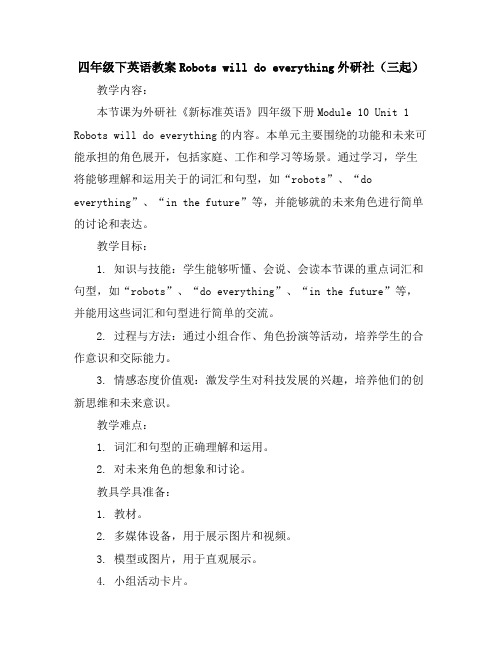
四年级下英语教案Robots will do everything外研社(三起)教学内容:本节课为外研社《新标准英语》四年级下册Module 10 Unit 1 Robots will do everything的内容。
本单元主要围绕的功能和未来可能承担的角色展开,包括家庭、工作和学习等场景。
通过学习,学生将能够理解和运用关于的词汇和句型,如“robots”、“do everything”、“in the future”等,并能够就的未来角色进行简单的讨论和表达。
教学目标:1. 知识与技能:学生能够听懂、会说、会读本节课的重点词汇和句型,如“robots”、“do everything”、“in the future”等,并能用这些词汇和句型进行简单的交流。
2. 过程与方法:通过小组合作、角色扮演等活动,培养学生的合作意识和交际能力。
3. 情感态度价值观:激发学生对科技发展的兴趣,培养他们的创新思维和未来意识。
教学难点:1. 词汇和句型的正确理解和运用。
2. 对未来角色的想象和讨论。
教具学具准备:1. 教材。
2. 多媒体设备,用于展示图片和视频。
3. 模型或图片,用于直观展示。
4. 小组活动卡片。
教学过程:1. 导入:通过展示图片或视频,引发学生对的兴趣,导入本节课的主题。
2. 新课呈现:通过图片、实物等直观教具,教授本节课的重点词汇和句型。
3. 操练:通过小组合作、角色扮演等活动,让学生在实际语境中运用所学知识。
4. 巩固:通过听、说、读、写等多种形式,巩固学生对词汇和句型的掌握。
板书设计:1. 课题:Robots will do everything2. 重点词汇:robots、do everything、in the future3. 句型:Robots will do everything in the future.作业设计:1. 抄写本节课的重点词汇和句型。
2. 用所学句型编写一个关于未来的小对话。
外研版(三起点)四年级下册英语模块十备课M10

小学英语基于标准的教学案例单位名称: 适用年级:四年级设计者:模块备课课题名称:外研版(三起点)四年级下册M10一、目标确定依据1. 相关课程标准论述(1)能够看图识词,能在图片和情境的帮助下,认读所学单词。
(2)能在教师的帮助和图片的提示下,听懂、读懂简单的小故事。
(3)能根据录音模仿说话,正确朗读和复述课文。
(4)能模根据图片、词语或例句的提示,写出简短的语句。
(5)在学习中乐于模仿、敢于表达。
乐于感知并积极尝试使用英语。
2. 教材分析这一课是继第九模块学习一般过去时的一般疑问句“Did…”及其相应回答之后,继续强化巩固学习这一句型并加深了难度;同时,这一课还将呈现出更多动词的规则变化与不规则变化的过去式形式。
这一课的课文情境是Lingling和Amy看见Daning头上绑着绷带,就问Daming发生了什么事。
Daming向她们描述了昨天的经历,这一课教学内容生动有趣,教学形式丰富多样,为学生的学习创造了良好的条件。
3.学情分析四年级学生在经过前面第六至第九模块的学习,已经初步掌握了一般过去时,有了一定英语水平,但学生人数较多,掌握情况参差不齐,需要加强练习。
同时小学生课堂更加注重听说的练习,侧重语音语调的模仿,要求学生能够掌握一些新词汇和重点句型的认读与运用,由于班中学生两级分化情况严重,所以在关注学生学习学情时,应对学因生多加关注,确保基础知识的全部掌握。
二、课时安排:4 课时第一单元备课课题名称:M10U1 Did you fall off your bike?一、学习目标1.在图片、动作演示的帮助下,听懂会说能读单词及短语fall-fell, town, happen, ride, fall off, fall down。
2.在音频动画以及图片帮助下听懂会说能读并初步运用Did you fall off your bike? Did you buy some water?并作出相应回答。
四年级下册英语教案Module10Unit2Samhadlotsofchocolate外研社(三起)

四年级下册英语教案Module 10 Unit 2 Sam had lots of chocolate 外研社(三起)教学内容本节课为外研社三起四年级下册英语第十模块第二单元《Sam had lots of chocolate》。
教学内容围绕Sam和小朋友们的巧克力分享活动展开,通过故事情节的讲述,学生能够学习并掌握一般过去时态,以及相关的食物和数量词汇。
教学目标1. 学生能够理解并运用一般过去时态描述过去发生的事情。
2. 学生能够听懂、会说、会读本节课的关键词汇和句子。
3. 学生能够通过故事情节,学会分享的重要性。
教学难点1. 一般过去时态的构成及运用。
2. 数量词汇的理解和运用。
3. 故事情节的理解和复述。
教具学具准备1. 多媒体教学设备2. 教学课件3. 巧克力道具4. 学生课本教学过程1. 导入:通过图片展示,引导学生回顾上一节课的内容,为新课的学习做好铺垫。
2. 新课内容学习:通过故事情节的讲述,教授新课的词汇和句子,让学生在情境中学习并运用一般过去时态。
3. 情境练习:设置情境,让学生分组进行角色扮演,练习本节课所学内容。
4. 巩固提高:通过游戏、问答等形式,巩固学生对本节课知识点的掌握。
板书设计1. Module 10 Unit 2 Sam had lots of chocolate2. 重点词汇:chocolate, had, lots of, eat, share3. 重点句子:Sam had lots of chocolate. He ate some and shared some with his friends.作业设计1. 完成课后练习题。
2. 根据故事情节,编写一个小对话,运用一般过去时态。
3. 收集更多关于食物和数量的词汇,准备下一节课的分享。
课后反思本节课通过故事情节的讲述,让学生在情境中学习并运用一般过去时态,达到了预期的教学目标。
在教学过程中,注意引导学生积极参与,提高学生的听说能力。
外研版四年级下册英语教案module10教案

外研版四年级下册英语教案module10教案本文是()教案频道为大家整理的《外研版四年级下册英语教案module10教案》,供大家学习参考。
外研版四年级下册英语教案module10教案(一)(外研版)四年级英语下册教案Module10Module 10 AccidentsUnit 1 Sam fell off his bike.Teaching aims:Sam and I went for a bike ride yesterday.and then...?Teaching importance:Describing an accidentTeaching difficulities:Using the simple past tense of irregular and regular verbs to talk about past activities. Teaching Tools:RecorderTeaching Steps:Step one : Warm upsing a song.Step two:listen and point1 Ask questions about the pictures inChinese,e.g. What was Daming thinking about in Picture 1? What was he thinkingabout in picture2?What was Daming thinking about in picture3? How did Sam carry the watermelon in picture4?What happened to Daming in the last picture? What did the girls do in the last picture?2 Write thewords'then','and' and'so'on theboard.Explainthat these words link sentences or clauses together.Say that 'so'indicates result,e.g. I went to bed at 11p.m.,so I was late for school.Point out that 'and' means 'following this'Show the example in Pictures5and 6,i.e.Then Sam fell off his bike!And the watermelon bumped my head! Theadverb'then'means'after that'.We often use'then'when we are givinga sequence of instructions.Step three:Tell the story1)Write the following on the board:I ate ten nangoes,so...I didn't do my homework,so...I cleaned my teeth and then I...I fell over and...2)Have the students work in pairs and complete the sentences.Explain that there is no one correct answer forthis exercise,however,the sentences must be grammatically corret and they must make sense.Example Answers:I ate ten mangoes, so I wassick/went to bed/went to the doctor.I didn't do my homework, so my mother was angry/the teacher was angry.I cleaned my teeth and then I went to bed/watched TV/read a book.I fell over and hurt my knee/I cried.Step four: Homework【外研版四年级下册英语教案module10教案】Unit 2 Sam had lots of chocolate biscuits.Teaching aims:Sam had lots ofchocolate biscuits yesterday,【外研版四年级下册英语教案module10教案】so today he's got a stomachache.Teaching importance:Talking about illnessesTeaching difficulities:Using conjunctions 'so'and'and' to link ideasTeaching Tools:RecorderTeaching Steps:Step one : Warm upsing a song.Step two:Listen and pointExplain to the students that you are going to call out the names of the characters and they have to say what they did or had yesterday.Examples:T:Lingling.S:Lingling had a headache.T:Sam.S:Sam had lots of chocolate biscuits.Follow the same procedure but ask about today.Examples:T:Lingling.S:Lingling has got a fever.T:Sam.S:Sam has got a stomachache.Step three:Let's chant.1)Free talk:Have the students look at the pictures and say what the chant is about.Ask the students what they do when they are sickbut not seriouslyill,e.g.go to bed, take medicine,go to the doctor.2)Play the spoken version of the chant and get the students to repeat the words.3)Play the second version and let the students listen or they can say the chant along with the music.4)Divide the class into three groups.Each group has to say one verse of the chant.5)Have each student get a large piece of paper.The studnets in each group should look at their verse and write thelast word in the verse on their piece of paper,e.g. Group A shouldwrite'cold'.6)Tell the studetns that when they say their verse,they haveto hold up their word when it is repeated in the last line.7)Get the class to say the chant with each group saying theirverse and holding up their word at the appropritate time.8)Have the students change the names in the chant.As'Tommy'and'Lingling 'each have two syllables,you must use two-syllable names as substitutes,e.g.Amy,Daming.Thename 9;Ben'has one syllable so you can use 'Tom'or'Sam'as a substitute.Then have the students say the chant again with the new names.Step four: HomeworkModule 9 教材分析:在之前学习的基础上,开始对一般过去时的问句进行学习。
(外研版)四年级英语下册教案 MODULE10 unit1
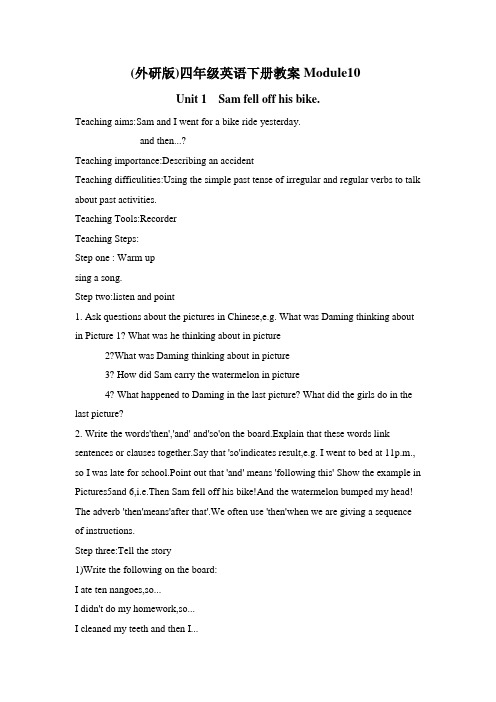
(外研版)四年级英语下册教案Module10Unit 1 Sam fell off his bike.Teaching aims:Sam and I went for a bike ride yesterday.and then...?Teaching importance:Describing an accidentTeaching difficulities:Using the simple past tense of irregular and regular verbs to talk about past activities.Teaching Tools:RecorderTeaching Steps:Step one : Warm upsing a song.Step two:listen and point1. Ask questions about the pictures in Chinese,e.g. What was Daming thinking about in Picture 1? What was he thinking about in picture2?What was Daming thinking about in picture3? How did Sam carry the watermelon in picture4? What happened to Daming in the last picture? What did the girls do in the last picture?2. Write the words'then','and' and'so'on the board.Explain that these words link sentences or clauses together.Say that 'so'indicates result,e.g. I went to bed at 11p.m., so I was late for school.Point out that 'and' means 'following this' Show the example in Pictures5and 6,i.e.Then Sam fell off his bike!And the watermelon bumped my head! The adverb 'then'means'after that'.We often use 'then'when we are giving a sequence of instructions.Step three:Tell the story1)Write the following on the board:I ate ten nangoes,so...I didn't do my homework,so...I cleaned my teeth and then I...I fell over and...2)Have the students work in pairs and complete the sentences.Explain that there is no one correct answer for this exercise,however,the sentences must be grammatically corret and they must make sense.Example Answers:I ate ten mangoes, so I was sick/went to bed/went to the doctor.I didn't do my homework, so my mother was angry/the teacher was angry.I cleaned my teeth and then I went to bed/watched TV/read a book.I fell over and hurt my knee/I cried.Step four: HomeworkReview Module( Unit 1)Teaching aims:ReviewTeaching importance:ReviewTeaching difficulities:ReviewTeaching Tools:RecorderTeaching Steps:Step one : Warm upsing a song.Step two:Look at the map and say.1)Tell the students to imagine that the top of their desk (the flat part that they write on )is like a map with north at the top(this is the ide of the desk farthest away from the students),south at the bottom (this is the side closest to the students),west to the left and east to the right.2)Have the students get out their coloured pencils.3)Explain to the students that you are going to give instructions on where to place the pencils and they have to follow those instructions.e.g.put a red pencil in the south,please.Put a blue pencil in the north ,please.Do a lot of examples with the students.Step three:What will they do?1)Tell the students that you are going to choose a student and then say a day. The student has to say what he or she will do on that day.e.g.T:Sunday.S:I will visit my grandmother.T:Tuesday.S:I will play football.2)Do a lot of examples.Then have the students continue the activity in pairs. They should take turns to say the days.3)Point out that they can make up what they will do ; it doesn't have to be true. Step four: Homework。
四年级英语下册优质精品教案-Module 10 Unit 1 (1)-外研版(三起)
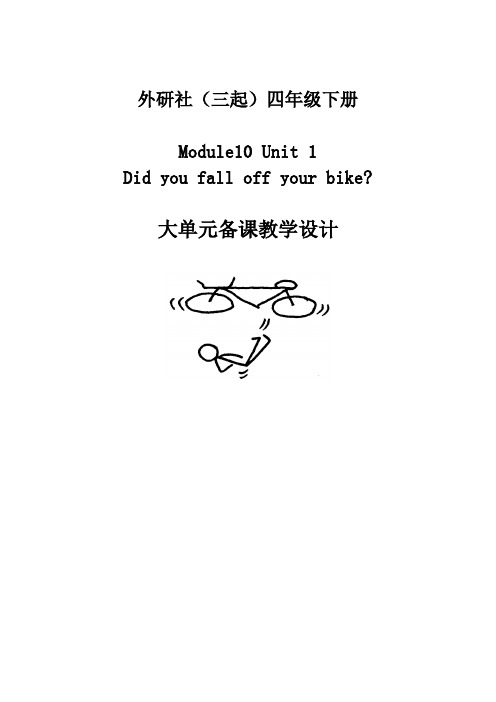
超市数据分析的基本思路和原则数据分析的基本思路和原则1.量化分析业绩状况2•规范商品部预算管理制度3.加强对商品部工作的考核管理4•用科学的方法提高经营管理水平5.整体提升商品部工作效率和专业水准6.数据与信息是有区别的,数据是客观事物的量化记录,对管理而言,是管理对象变化的量的记录7.信息是对数据的解释,表明了数据的因果关系数据的分类与采集-)数据的分类与控制数据是客观存在的,只要有行为发生,就会有量的变化(可能是负变化、零变化,或者是无穷变化),那么,这个量的变化的记录,就是数据。
从真正意义上来说,只有建立商业管理信息系统后,才能谈得上数据分析、数字化管理。
一般情况下,数据可以简单的分为:直接数据和间接数据两个大类直接数据:能反映行为表象的数据,如进货、销售、库存、毛利等实绩是组成采购《销售报表》《绩效报表》的基本元素间接数据:能影响行为实绩的数据如客流量、商品品项数、费用成本等二)IT在超市中的功能如果我们仅仅需要直接数据,也许简单的POS系统就能完成既然我们说是IT ,那么就不应该是只能看到简单的数字堆积,我们需要的是能把这些数据进行有机的组合,进行分析,得出我们有用的信息分析的基础是数据的针对性、及时性、准确性进货量、进价、销售量、售价都是变量,所以采购为了对市场作出快速反应,数据分析工作是阶段性、持续性的销售统计报表1 •来客数2.客单价3•部门销售额4.部门销售占比5•部门毛利6.部门库存7.部门库存天数 &预算与同期对比(天、月、年)商品销售排行表1 •各品类销售占80%的前20%商品毛利及库存量/库存天数2.各品类销售占20%的商品毛利及库存量/库存天数3•品牌排行4•供应商排行5.其他排行前后各100名的数据统计1 •商品状态/销售额/销售单位/平均日销售/平均周销售 /采购成本/零售价/毛利率/毛利额2.销售成本/现货量/现货金额/平均库存/在线订量/在线成本/在线订量利润毛利错误列表1.商品分类的毛利上限、下限2.促销期间促销单品的毛利3•造成商品毛利不正常现象的原因分析:系统差错、盘点问题、打折等4 •毛利和费用贴补竞争对手销售状况我们要持续地把外界的信息引进公司,了解竞争对手实际赚钱的范围1 .总体销售2.部门占比3.单品情况4•毛利水平5.分类动向权利与义务1 •采购体系在零售行业的许多经营管理模式里具有50%以上的企业驱动力,是连锁零售企业的核心2.权利与义务是相辅相成的3•清晰的权利义务划分可以减少并杜绝扯皮4.清晰的权利义务划分可以提高公司效率,提升公司战斗力及竞争力5•便于考核、激励制度的推行关于责任心1•责任心是保证公司利益的基础2•责任心是弥补流程及管理不足的最佳方法3•责任心是确保公司前进的动力之一4.采购服务门店5•门店支持采购沟通的重要性1 •沟通是统一思想的唯一有效方法2•沟通可以了解真实,整合大家的思路,减少误解,增加谅解3 •沟通可以使公司文化彻底灌输到最基层4•沟通可以确保每个成员都清晰了解5W1 H5 •沟通是一项技巧,一切用数据说话,是体现素质及能力的平台6•沟通可以解决流程所不能解决的问题,提高效率,体现快速反应机制相互影响关联图顾客不满:品牌不响、品种不对、包装不良、分量不足顾客不来:人气不够、交通不便、装潢不佳、布局不畅顾客不干:制度不严、操作不当、服务不周、设备不行战胜对手:价格形象、排面陈列、库存安全、促销策划领先对手:市场信息、物流配送、人力储备压迫对手:生产计划、工作效率、防损意识、食品安全原因现象关系图行业外部环境分析1 •计划经济时代商品短缺,供应商掌握资源、主导产品零售流通的局面不复存在,大流通商崛起形成买方市场;2.零售商和供应商处于利益分配的对立面,零售商控制着市场终端,进而想控制供应商,供应商希望能保留公平交流渠道;3.矛盾升级使得双方利益受损,外资企业稳定的战略同盟将会对本土企业造成巨大压力,有识之士明白要寻求利益平衡点,愿景规划一定要双赢才能实现。
(外研版三起)四年级英语下册Module10《Accidents》Unit1教案

(外研版三起)四年级英语下册Module 10《Accidents》Unit1 教案一、教学内容本课为外研版《英语》四年级下册Module 10《Accidents》Unit 1。
教学内容主要包括:词汇:hurt, cut, fall, get up, hospital, blood等;句型:What's wrong with you? I ;日常交际用语:Can I help you? Yes, please./No, thank you.;语法:一般过去时态的运用。
二、教学目标1. 知识与技能:学生能够听懂、会说、会读本课词汇和句型,并能运用一般过去时态描述过去发生的事情。
2. 过程与方法:通过小组合作、情境模拟等教学活动,培养学生英语听说能力和合作意识。
3. 情感态度价值观:培养学生关爱他人、乐于助人的品质,提高学生的安全意识。
三、教学难点1. 词汇:hurt, cut, fall, get up, hospital, blood的正确发音和运用。
2. 句型:What's wrong with you? I 的运用。
3. 语法:一般过去时态的运用。
四、教具学具准备1. 教具:多媒体课件、录音机、磁带、黑板、粉笔。
2. 学具:学生用书、练习册、英语词典、彩色笔。
五、教学过程1. 导入:通过播放与Accidents相关的视频,激发学生的学习兴趣,引导学生进入本课主题。
2. 新课呈现:教师通过图片、实物等教学手段,呈现本课词汇和句型,并进行讲解和示范。
3. 小组合作:学生分组进行角色扮演,模拟Accidents情境,运用本课所学词汇和句型进行交流。
4. 巩固练习:教师设计练习题,检测学生对本课内容的掌握程度,并进行讲解和指导。
六、板书设计1. 本课Module 10《Accidents》Unit 12. 词汇:hurt, cut, fall, get up, hospital, blood3. 句型:What's wrong with you? I4. 语法:一般过去时态的运用七、作业设计1.抄写本课词汇和句型。
外研社版三起英语四年级下册第十单元教案

1.能识别语句:Did you fall off yourbike?
2.能识别单词:happen .ride.then .thirsty .watermelon .carry. bump. fell off. went. bought.
教学难点
根据提示书写Sam fell off his bike.
2.复习句型
3.导入语
1.学生板书单词。
2.指名对话。
二、习题
训练
1.写单词。
西瓜-----()
口渴的---()
携带-----()
磕、碰---()
发生-----()
然后-----()
骑、乘---()
2.写出下列动词过去式的原形。
went-----()
carried--()
were-----()
bumped---()
Module 10
单元
教材
分析
本单元包括Unit1Did you fall off yourbike?和unit2 Sam had lots of chocolate.两个单元。Unit1主要使学生学会用一般过去式时描述发生的意外事情。Unit2时学生用过去式表达疾病的成因并能口头运用have got表达得了什么病。
2.复习巩固单词及句型运用。
教学重点
熟练掌握单词及重点句型
教学难点
对所学知识的灵活运用
教学准备
课件
课时安排
1课时
教学环节
教学内容及教师活动
学生活动
二次备课
一、复习
导入
1、指名读单词
2、复习课文
1.听写单词,集体订正单词读音。
2.学生推火车读课文
- 1、下载文档前请自行甄别文档内容的完整性,平台不提供额外的编辑、内容补充、找答案等附加服务。
- 2、"仅部分预览"的文档,不可在线预览部分如存在完整性等问题,可反馈申请退款(可完整预览的文档不适用该条件!)。
- 3、如文档侵犯您的权益,请联系客服反馈,我们会尽快为您处理(人工客服工作时间:9:00-18:30)。
请学生翻开课文第二单元活动一,教师放录音学生边听边看书。
课文讲解完毕后,教师再放录音机,每句话后停顿,请学生跟读。
师请学生看活动4韵诗的插图,然后提问:
What’s wrong with little Tommy?
What’s wrong with little Lingling?
What’s wrong with little Ben?
1.单词:stomachache cold headache fever have
2.句型:Sam\Daming\Amy\Lingling
……had……yesterday so(and)today……
教学反思
第二课时
课题
Review lesson
主备人
蔡兆淼
授课班级
四年级
授课人
授课时间
教学目标
1.掌握一般过去时的结构。
教学重点
学习本课的句型:
Sam had lots of chocolate biscuits yesterday sotoday.
He’s got a stomachache.
教学难点
能利用本课的词汇和句型组成复合句表示因果关系。
教学准备
录音机、图片
课时安排
1课时
教学环节
教学内容及教师活动
学生活动
二次备课
单元
教学
目标
一、知识与技能
1.通过学习使学生能运用一般过去是时描述发生的意外事件和表达疾病的成因。
2.学习单词:happen.ride.then.thirsty.watermelon.carrybump.fell off.went.bought.stomachache.head.fever.have。
2.复习句型
3.导入语
1.学生板书单词。
2.指名对话。
二、习题
训练
1.写单词。
西瓜-----( )
口渴的---( )
携带-----( )
磕、碰---( )
发生-----( )
然后-----( )
骑、乘---( )
2.写出下列动词过去式的原形。
went-----( )
carried--( )
were-----( )
小组试着分角色朗读,共同解决疑难问题。
比较规则和不规则动词的过去式形式。如:buy--bought,
go--went,
fall--fell.
学生记忆单词
学生跟读课文
三、巩固
练习
分组活动复述课文故事并表演出来。
用英语在小组内交流
四、小结
说说今天的收获?
自由说说
五、作业
1.熟读对话。
2.记忆单词、重点句型。
5.讲解课文。告诉学生:“Whathappened(to)?”用于询问别人发生了什么事情。再举几个例子鼓励学生造句,给以肯定表扬。
告诉学生:在讲述一个事情时,可以用"so"来连接有因果关系的句子,用“then"来连接有时间联系的句子。
放录音领读,学生跟读。
学生自读课文,并试着翻译汉语,遇到不懂的地方用铅笔做记号。
板书设计
Unit 1Did you fall off your bike?
单词:
happen .ride. then .thirsty .
watermelon .carry. bump. fell off.
语句:
Sam fell off his bike.
And the watermelon bumped my head.
同桌交流,订正
三、小结
说说学到了什么?
说说收获。
四、作业
1.记忆本课单词。
2.完成练习。
教学反思
第一课时
课题
Unit2Sam had lots of chocolate.
主备人
蔡兆淼
授课班级
四年级
授课人
授课时间
教学目标
1.学生能够运用过去式来表达疾病的成因,Sam had lots of chocolate biscuits.
talk
happen
fall
is
bump
watch
2.连词成句。
(1)She′s headache got
(2)Amy a yesterday had cold
(3)has got she stomachache a
(4)was she thirsty
3.选择正确答案。
Yesterday,Sam and I(go,went) to the park.We went for a bike ride in the park.We(buyed,bought) thewatermelon.Sam (carried,carryed )the watermelon on the bike. Then Sam(falled,fell)off bike.
教学重点
1.能识别语句:Did you falloffyourbike?
2.能识别单词:happen .ride.then .thirsty .watermelon .carry. bump. fell off.went.bought.
教学难点
根据提示书写Sam fell off his bike.
教学反思
第二课时
课题
Review lesson
主备人
蔡兆淼
授课班级
四年级
授课人
授课时间
教学目标
1.掌握一般过去时的结构。
2.复习巩固单词及句型运用。
教学重点
熟练掌握单词及重点句型
教学难点
一般过去时的各种句型
教学准备
课件
课时安排
1课时
教学环节
教学内容及教师活动
学生活动
二次备课
一、复习
导入
1.复习上节课的单词
Thewatermelon on bumped my head.
指名板演,其余学生在练习本上做。
同桌交流,订正
集体订正
三、小结
说说到学了什么?
自由说说收获。
四、作业
1.记忆本课单词。
2.完成练习。
教学反思
3.注意卫生,保持健康,对学生进行安全知识教育。
单元训练重难点
重点
难点
1学习Sam fell off his bike.这类句型。
2、学习单词:happen ride then……书写单词:cold.
通过学习使学生能运用一般过去时描述发生的意外事件和表达疾病的成因。
单元
课时
安排
Unit 1 2课时
Unit 2 2课时
Module10
单元
教材
分析
本单元包括Unit1Did you falloffyourbike?和 unit2 Sam had lots of chocolate.两个单元。Unit1主要使学生学会用一般过去式时描述发生的意外事情。Unit2时学生用过去式表达疾病的成因并能口头运用have got表达得了什么病。
请学生仔细阅读,然后放录音认真听。
放录音,学生跟读。
情景教学师生操练
学生边听边看书,看看自己的猜测是否正确
跟读课文听音模仿
学生注意观察韵诗诗句,特别是每行的最后一个单词
三、小结
说说本节课有什么收获?
自由谈感想及收获。
四、作业
1.熟读课文及韵诗。
2.记忆单词、重点句型。
板书设计
Unit 2Sam had lots of chocolate biscuits
一、复习
导入
1.检查上节课的单词。
2.对话练习上节课的句型。
1.学生默写。
2.对话练习。
二、新授
1.课文导入:
让学生谈论医院病人的情况、并分别让学生扮演病人的表情,说出他们的病因。
2.学习单词:
stomachachecold
headachefever have
Amy Lingling昨天的行为引发今天什么后果?
3.学习Sam fell off his bike.这类语句,能听懂用一般过去时表达的语句。
二、过程与方法
1.让学生通过热身复习课文学习达标测试等学习过程学习知识。
2.通过听说、演唱等游戏活动运用所学语句,达到巩固提高的目的。
三、情感、态度、价值观
1.培养学生的语感和节奏感,提高发音的正确性。
2.通过本单元的学习使学生能用英语描述过去发生的事情。
教学准备
录音机
课时安排
1课时
教学环节
教学内容及教师活动
学生活动
二次备课
一、复习
导入
师生互相问好。请学生一起做一个Whatdid you do yestday?的接龙游戏。教师将活动中用到的动词写在黑板上,将不规则动词分类书写。最后,教师请学生观察板书内容,找一找两组动词的规律。
学生回答问题
二、新授
1.导入新课:教师讲述课文的主人公及有关事物,请学生猜一猜会发生怎样的事情。然后告诉学生:“昨天Daming和Sam一起出去玩,结果发生了一件有趣的事情。然后可以让学生自己讲一讲发生的有趣的经历。
第一课时
课题
Unit 1Did you fall off your bike?
主备人
蔡兆淼
授课班级
四年级
授课人
授课时间
教学目标
1.学习Did you falloffyourbike?这类句型,能听懂And the watermelon bumped my head.这类用一般过去式表达的语句。
2.能识别单词:happen .ride.then .thirsty .watermelon .carry. bump. fell off.went.bought不做书写要求。
